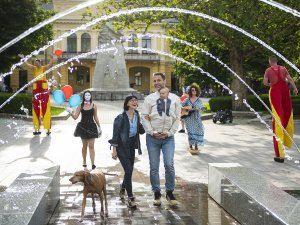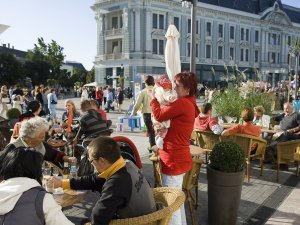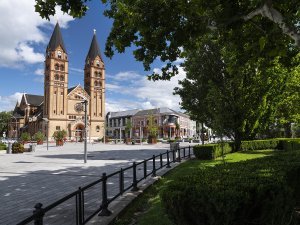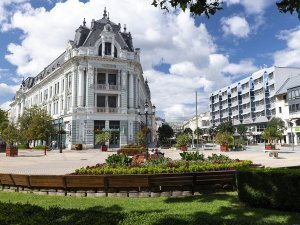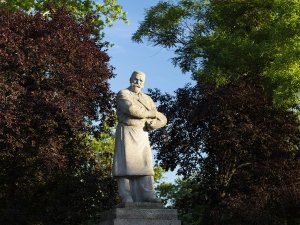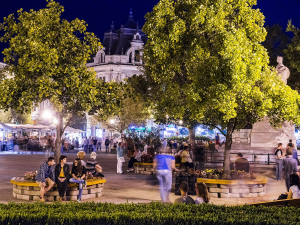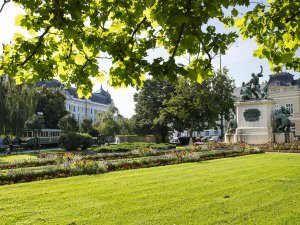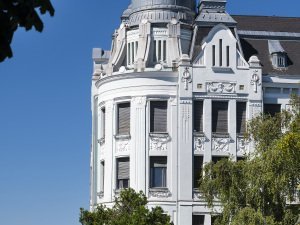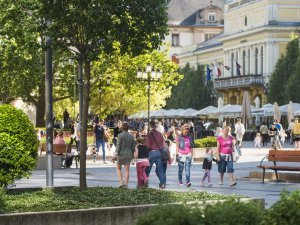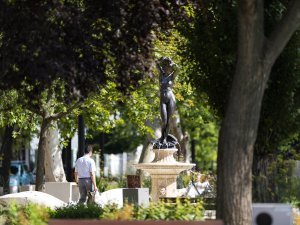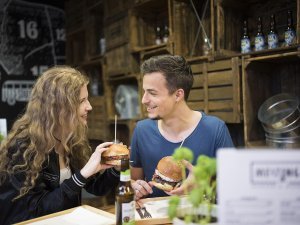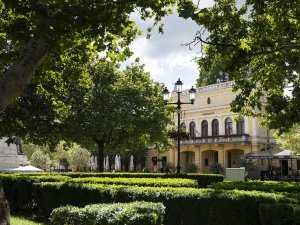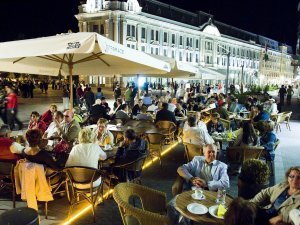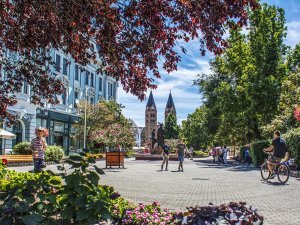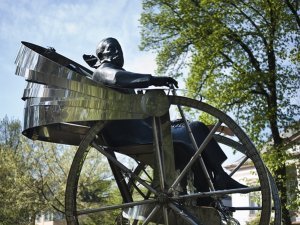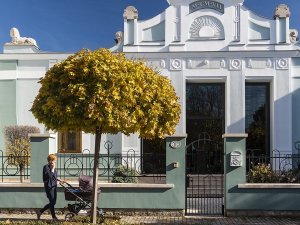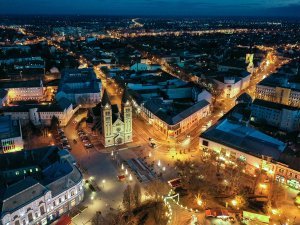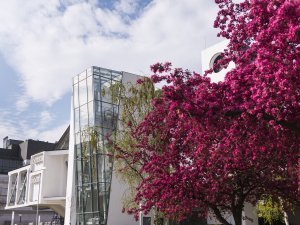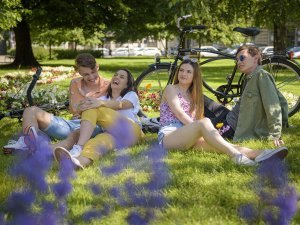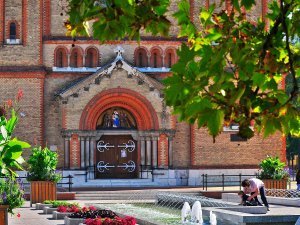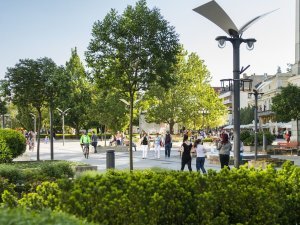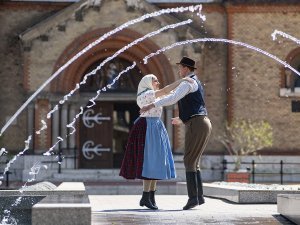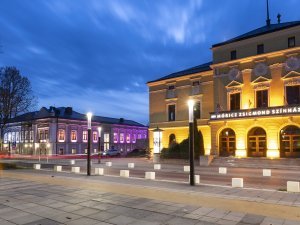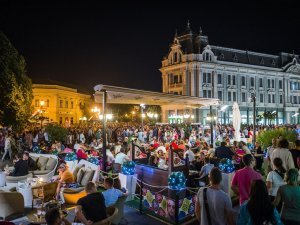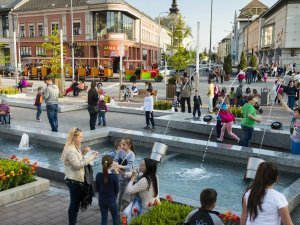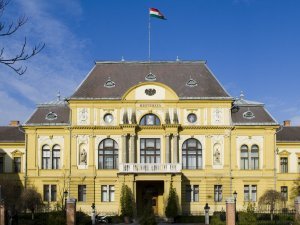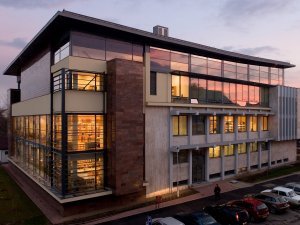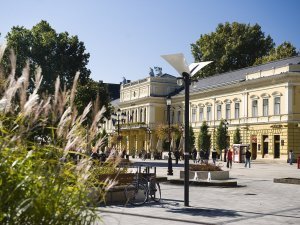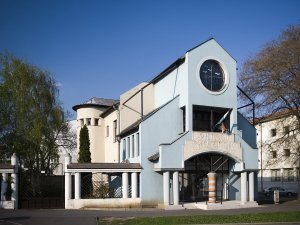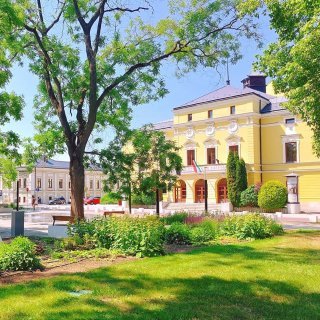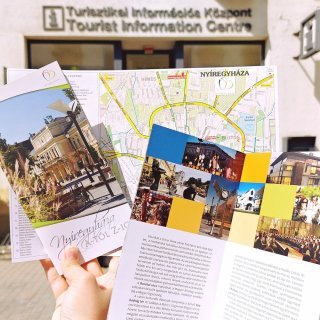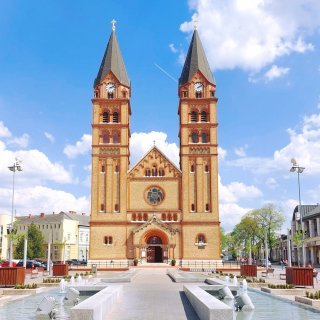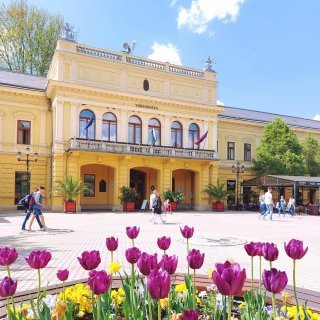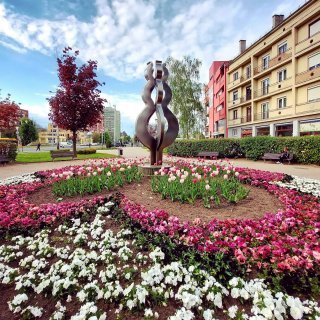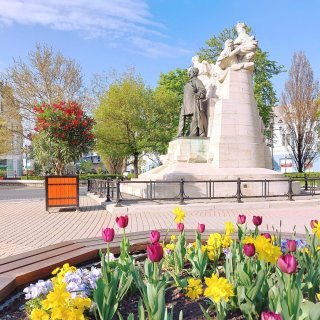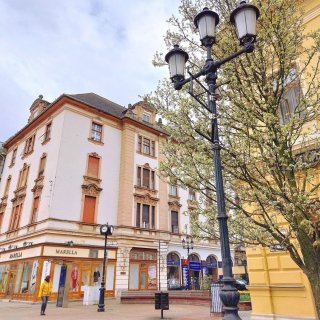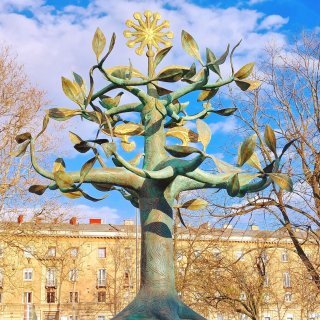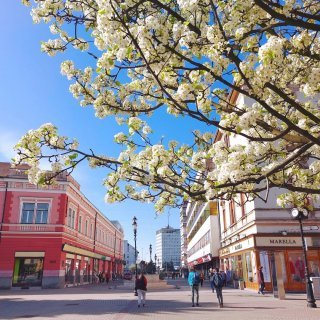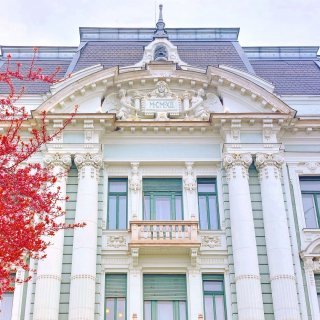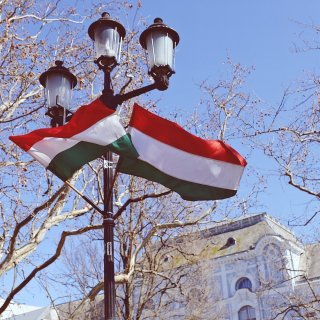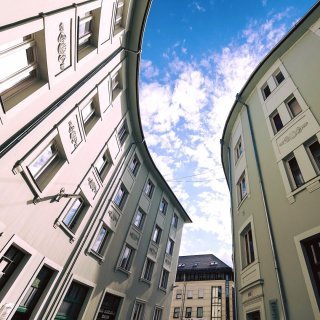Let yourself be carried away by the beauty and atmosphere of the downtown.
Mihály Váci, a famous person born here, said about the inner city: ‘… not a historic city. No battles or peace treaties are associated with its name, there aren’t a number of famous historic places, old monuments with kings’ footprints here …’ but its beauty and atmosphere can carry visitors away.
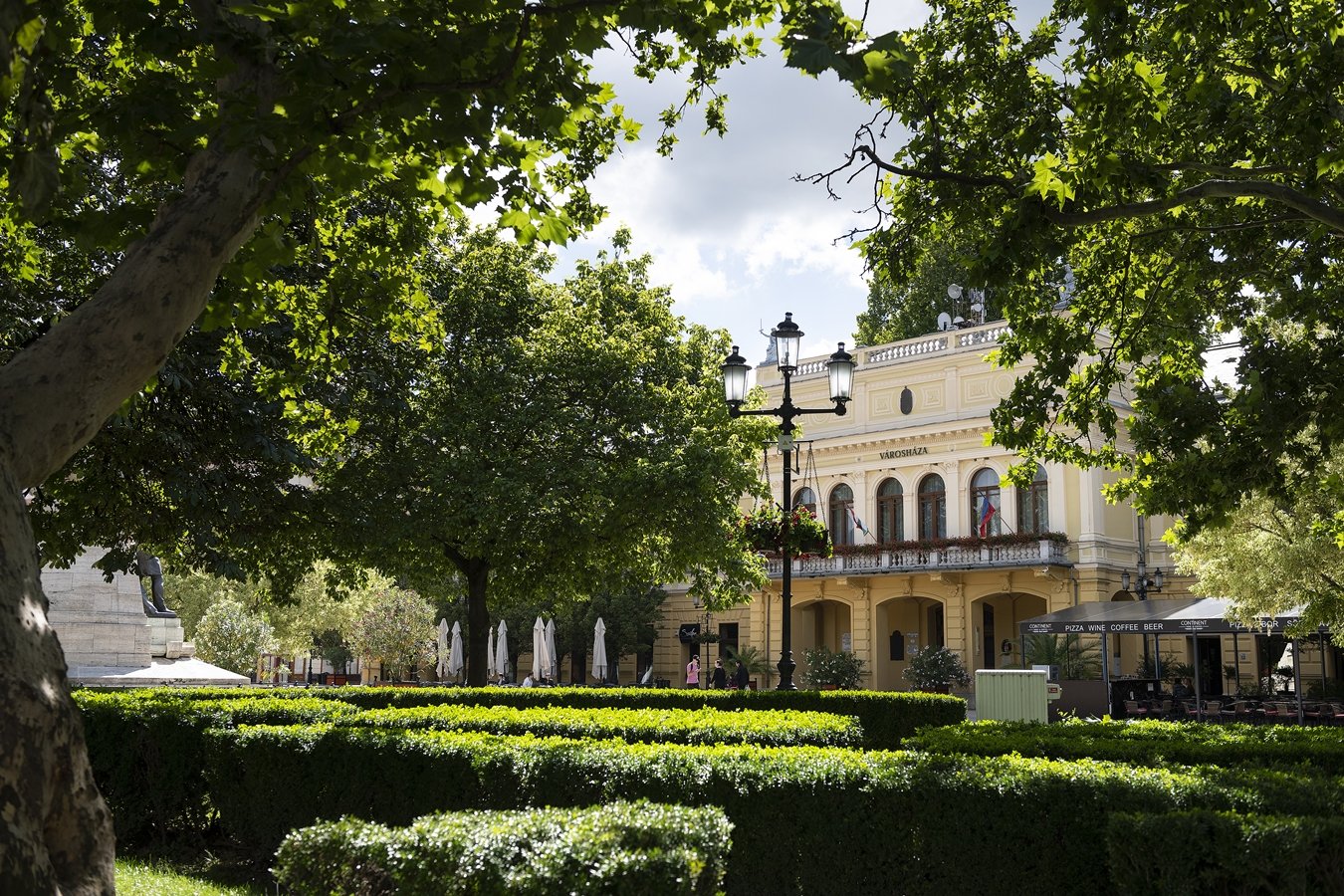
The starting point: the Kossuth square
If it’s your first time in Nyíregyháza, you should start your visit at the city’s main square, the Kossuth square. The decorative pavement of the Kossuth square symbolises the solar system with nine round mosaics representing the planets. The most dominant building at the square is the City Hall, designed by Károly Benkó. The building, which has an arcaded entrance and a renaissance atmosphere, was built in 1872 in an eclectic style. It is the assembly hall of this building where the infamous ‘Tiszaeszlár trial’ took place; its walls have seen many famous Hungarians such as Károly Eötvös, Kálmán Mikszáth; and Zsigmond Móricz stayed in its guest room. The facade, above the balcony facing the square, features a Justitia statue on each side.
A monument of Lajos Kossuth, prepared by Gyula Bethlen, can be seen in the middle of the square. At the back of the statue there is a bird on a broken bore of a cannon, and under them a date: 1848. The Memorial Column for the Compulsory Fee Simple stands in the shades of old buckeye trees, with peasants with doubtful face on its left and trustful face on its right side – ’The city of Nyíregyháza is no longer under the patrimony and power of landlords’.
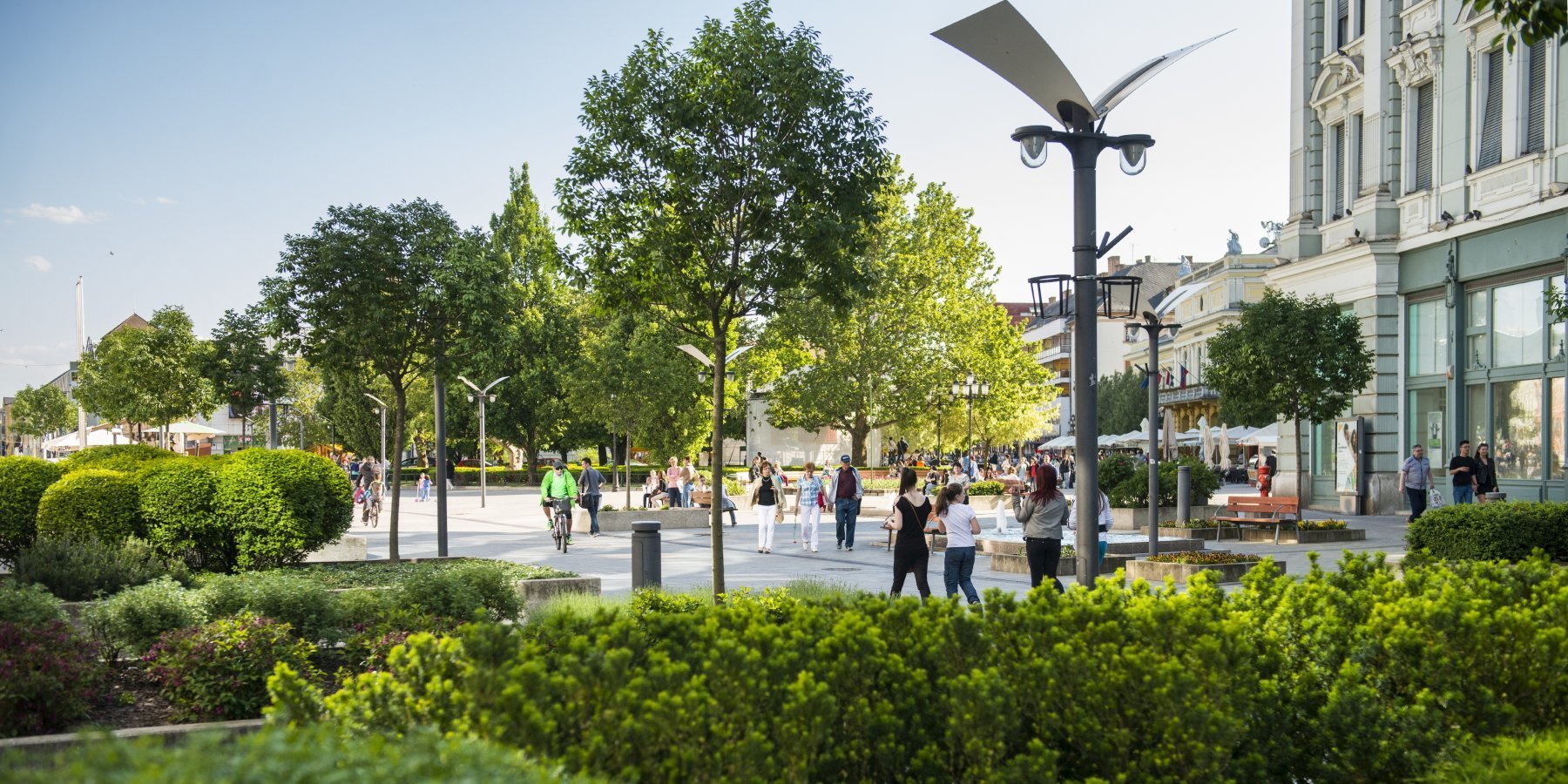
The square continues in the eclectic buildings of the Savings Palace built in 1912 according to the designs of József Hubert, the cashier’s hall (a protected monument) of which is covered by a dome with colourful painted glass.
Across it stands the Crown Hotel, one of the – also eclectic – end-of-the-century buildings of the city, constructed in 1895 according to the plans of Ignác Alpár. Each of its three fronts shows a different picture to spectators. It’s an interesting fact that electric light was first used in the city at a ball at the building’s opening ceremony.
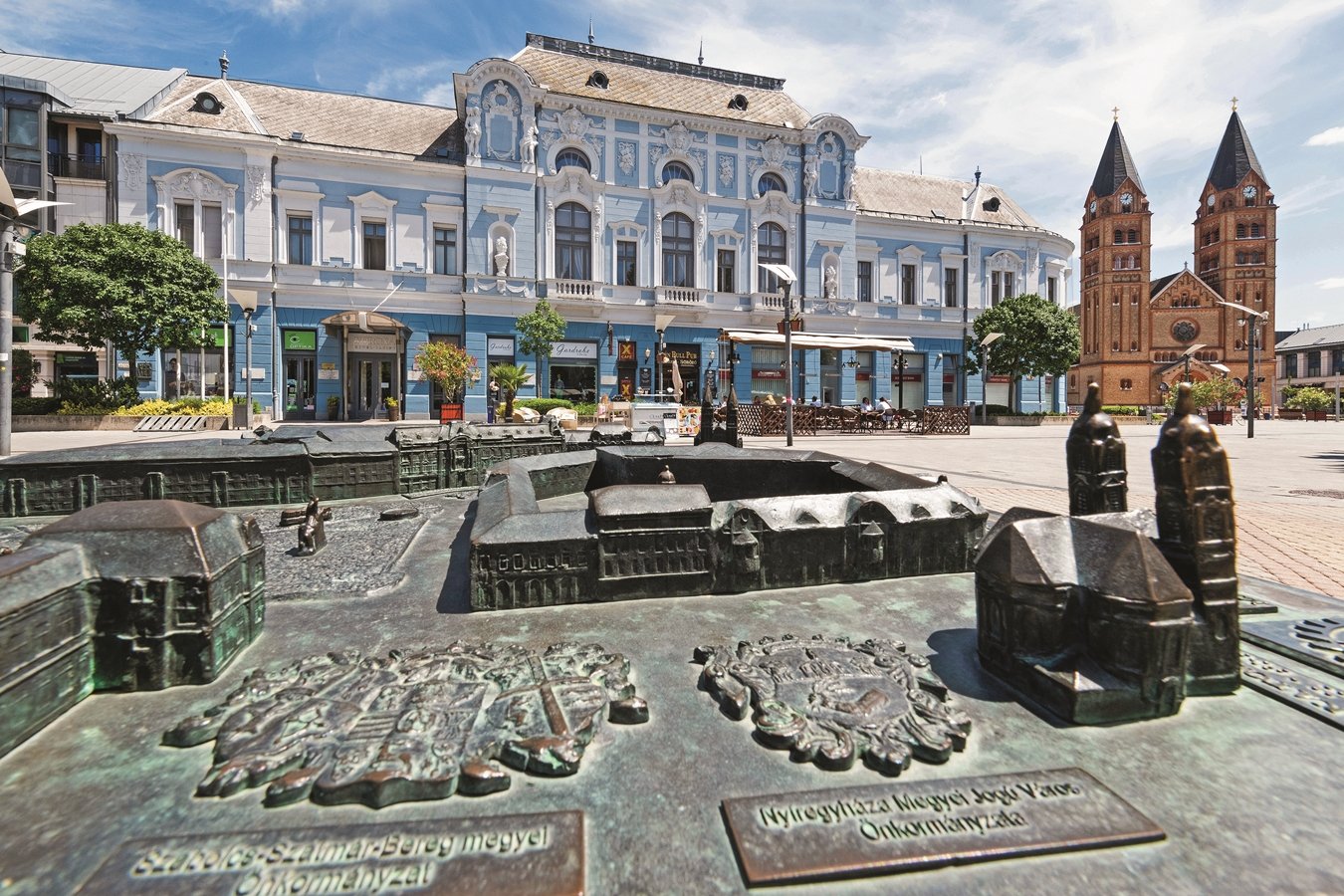
The Roman Catholic church built by Virgil Nagy stands next to the hotel. The most beautiful part of the three-nave church, arranged as a basilica, is the monumental transept. This hosts a marble rostrum, with the portal figures of the four evangelists in its bays. The Bishop’s Palace of the Debrecen – Nyíregyházi Roman Catholic Diocese is located next to the church.
Sights in Zrínyi Ilona street
Continuing your way in Zrínyi Ilona street, you will see two nice buildings: the Neo-Baroque Catholic mansions and the former Roman Catholic parish. Between them, a bronze ornament well by Tibor Borbás called ‘The Three Graces’, featuring three bathing girls, attracts your attention. The art-nouveau palace in the middle section of the street hosts the city’s marriage hall. Anyone who’s been there once will surely remember the medley atmosphere of this small street. From spring till autumn the myriads of flowers and shrubs radiate a Mediterranean atmosphere, and passers-by can listen to the music of street musicians at the statue of the bronze girls.
Sights in Bocskai street
Towards Bocskai street you can see the building of the County Court constructed in empire style, and next to it the building of the County Prosecutor’s Office.
Szabadság square, the centre of cultural life
The centre of the city’s cultural life is Szabadság (‘Liberty’) square. This hosts the Móricz Zsigmond County and City Library and the interestingly shaped building of the Váci Mihály Cultural Centre, designed by Ferenc Bán. At the opposite side of the street behind the building stands the blue-coloured building of the City Gallery, hosting the permanent exhibitions of the ‘Sóstó Medal Making Art Camp’, as well as temporary fine arts exhibitions.
Next to the City Gallery you can find the new Kodály Zoltán Primary School with its modern concert hall, which can count the world famous Cantemus Choir among its guests. The building’s Pál Gyula Hall hosts temporary exhibitions. After a small detour we can reach the Continental Arena. This building serves as the venue for several high-ranking sporting events, and also hosts different fairs and exhibitions throughout the year. The part of the city after this block is called ‘Bujtos’, the venue of the famous duels Gyula Krúdy, the famous Hungarian writer, wrote about. This marshy are has mostly been reclaimed by today, and a leisure park has been developed here.
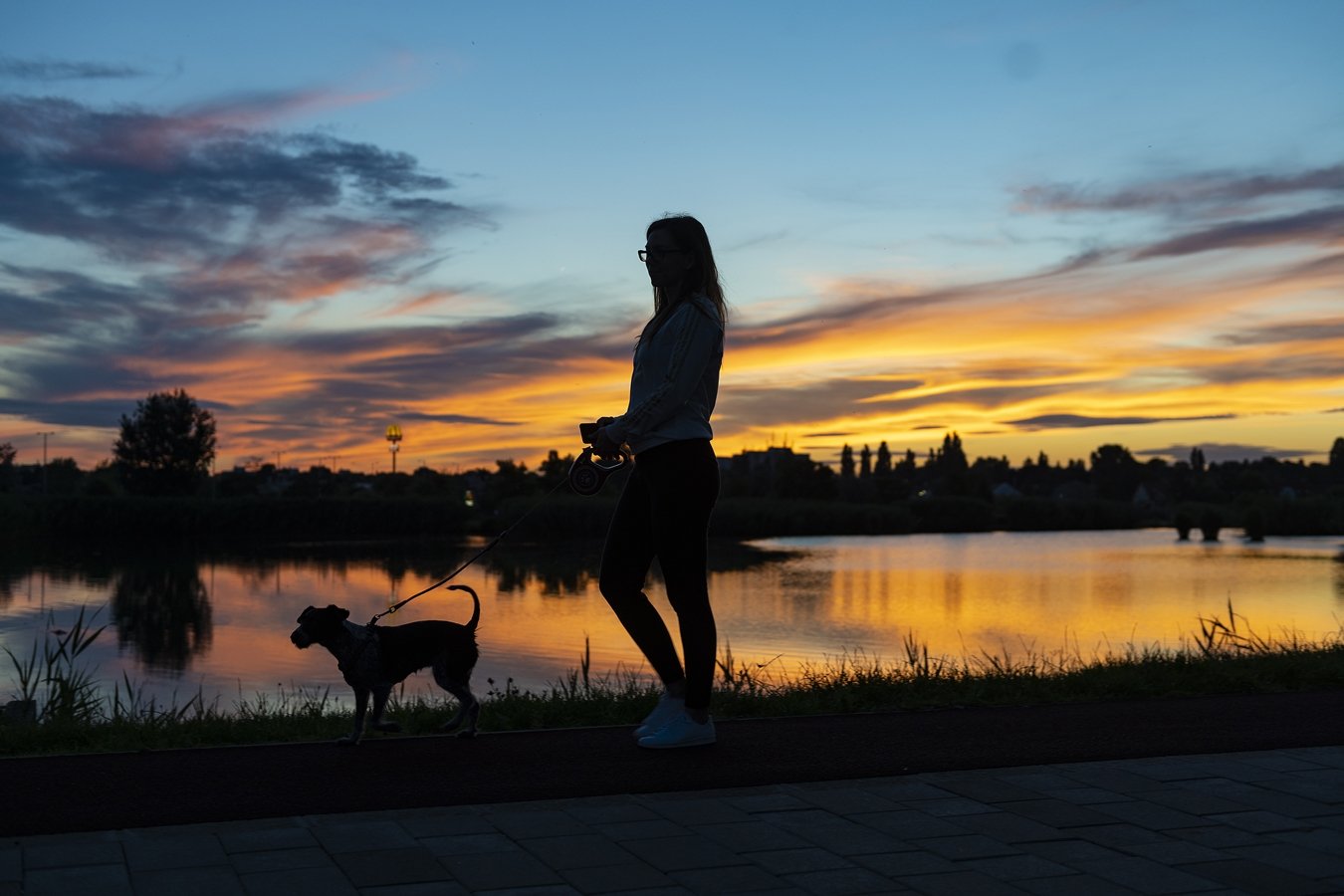
Heading back towards downtown, opposite the Savings Bank you can find the Statue of the City Founders which was unveiled in 2001. The statue – created by Benedek Nagy – depicts the Earl Ferenc Károlyi and János Petrikovics, a bootmaker from Szarvas, who were the main characters of repeopling the city in 1753 after it had started to lose its population.
Hősök tere (‘Heroes’ Square’)
The grand building of the County House, combining the marks of eclecticism and historicism, is also the work of Ignác Alpár. In two cabins at the facade, the creations of Ede Kallós, ‘Leader Szabolcs’ and ‘King Stephen’, while in the ornamental courtyard the statues of two former prime ministers, born in the county, earl Menyhért Lónyay (1871-72) and Miklós Kállay (1942-1944) can be seen.
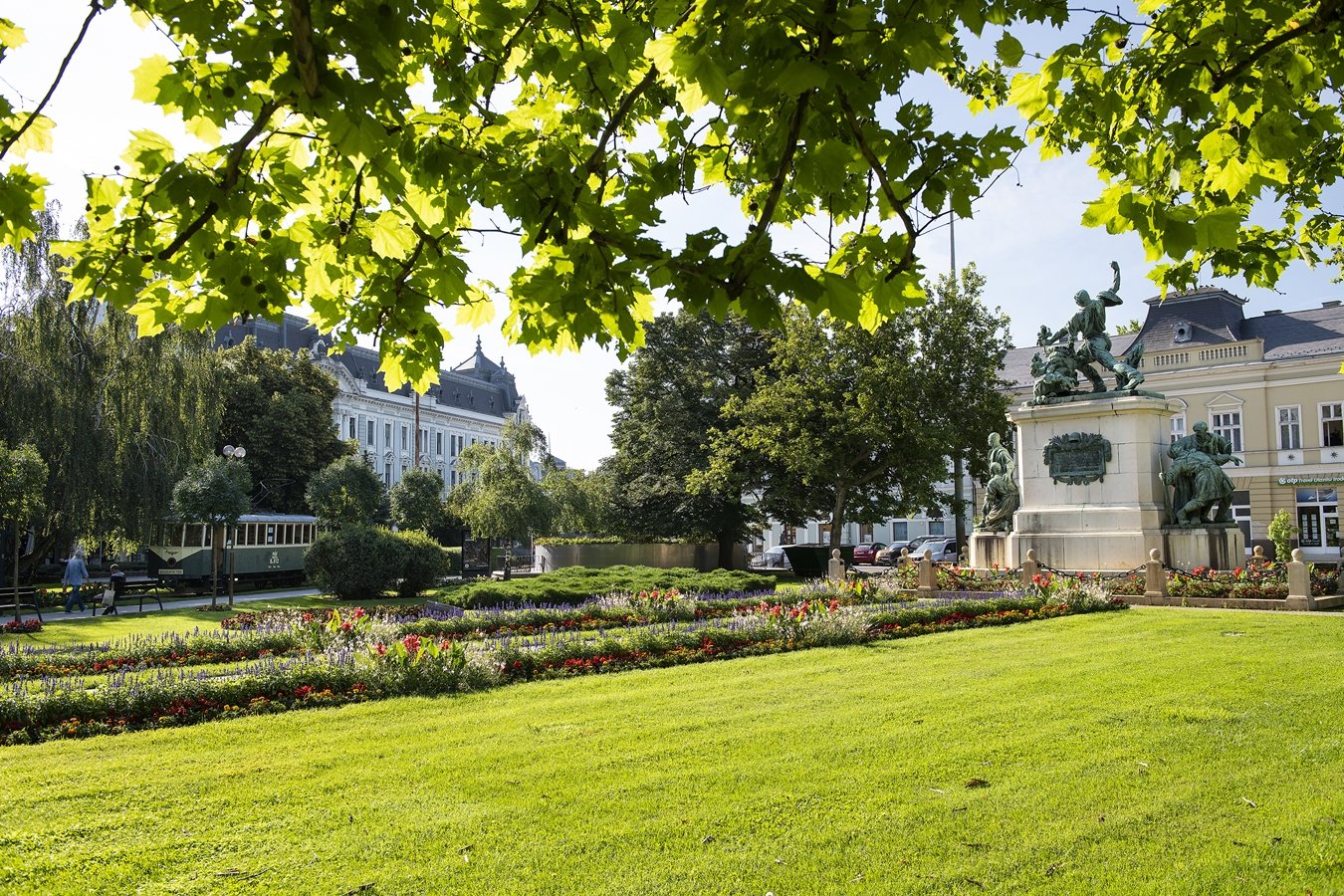
The park in front of the County Hall is dominated by a First World War monument created by Zsigmond Stróbl in 1928. Its main character is a hero fighting with a dragon, and the two auxiliary groups: going to the battle, and the end. The Dragonslayer on the Gellért Hill in Budapest is a slightly amended version of the statue in Nyíregyháza. At the opposite side of the square you can see Sándor Győrfi’s 1956 monument unveiled in 2006.
Október 23 square and its vicinity
The chrome steel sculpture in the round portraying a woman, standing on Október 23 square, is the Tree of Life created by Béla Tilles, symbolising the link between past and present, and the belief in the future. The bronze drinking fountain, depicting a cock, which is also located here is the creation of Lajos Orr. The orthodox synagogue constructed between 1924 and 1932 according to the plans of Lipót Baumhorn, can be found in the nearby Síp street. Not far from here you can see the distinctive red-brick building of the Saint Athanase Greek Catholic College of Theology, inaugurated in 2003.
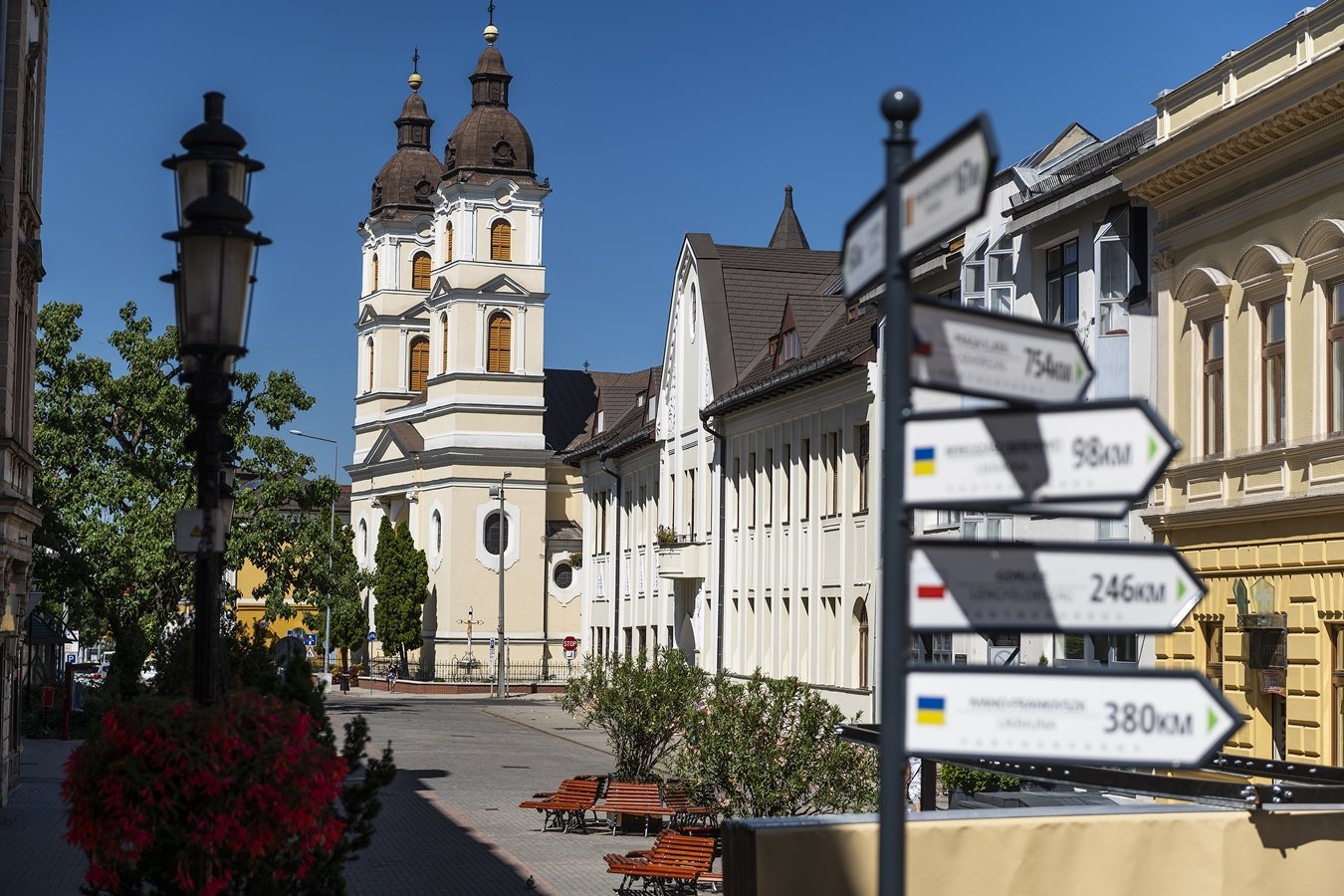
Continuing your way towards the inner city you can reach Bethlen Gábor street with the two-towered Greek Catholic church built in 1895 in a mixed Byzantine style. A fountain statue has been created of its patron saint, Saint Nicholas, by Sándor Tóth (1996), and this is where the small passage behind the church got its name from.
Kálvin square and Országzászló square
The dominant building on Kálvin square, the Reformed Church designed in romantic style, was built between 1873 and 1882. Kálvin square continues in Országzászló square, with the monument of the victims and martyrs of the Second World War, unveiled by former Prime Minister József Antall in 1991. At the southern part of the square, the bronze equestrian statue, ‘The Hungarian Hussar’, raised in the memory of hussars, will draw your attention.
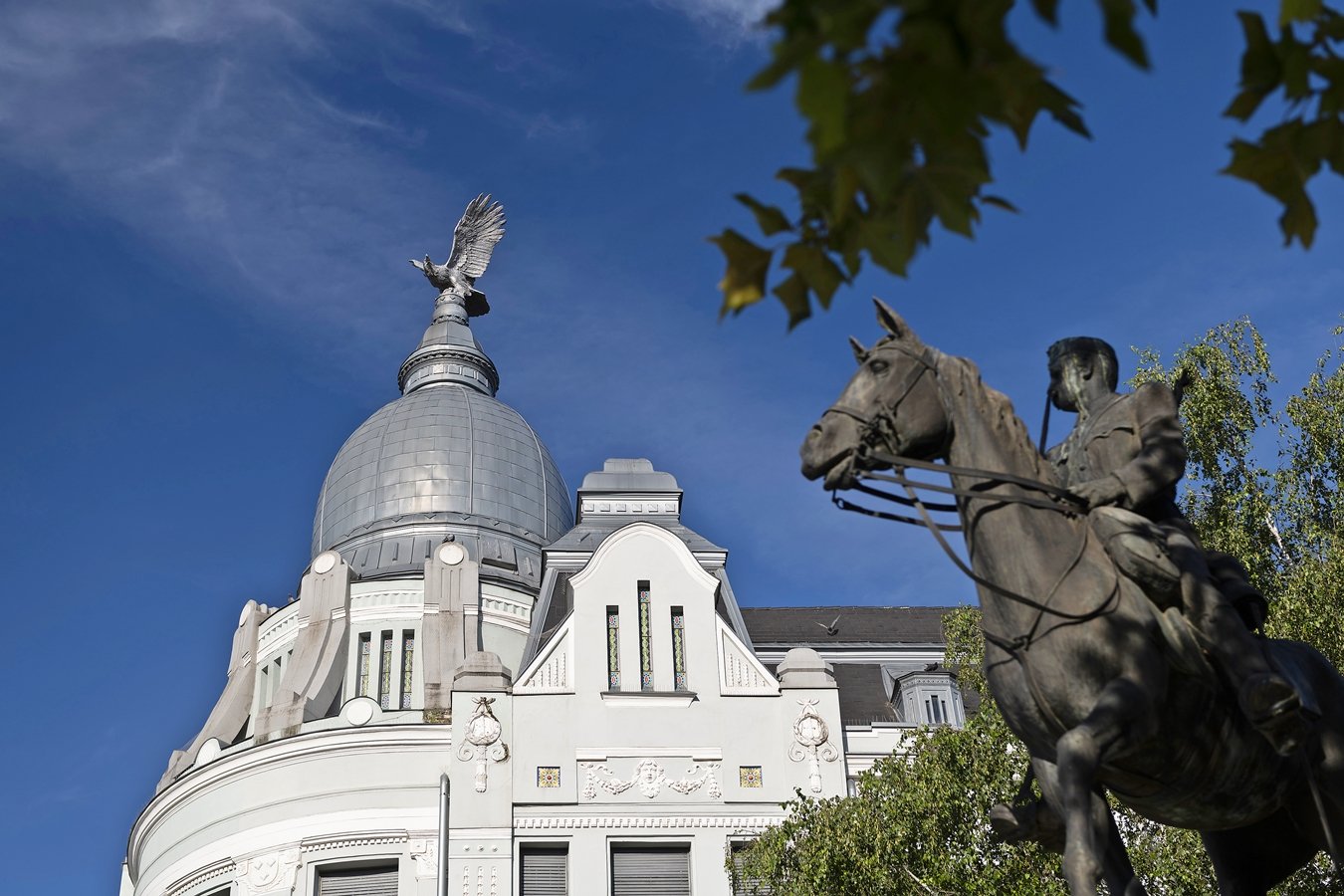
Hussars were part of the city’s life from 1869 when a cavalry regiment department of the Hungarian royal army moved into the city’s army post, and then in 1891, barracks suitable to host a whole cavalry regiment were built. The hussars played an important role in the city’s economic and social life until the 2nd World War.
The former Nyírvíz Palace, an art-nouveau corner building defining the cityscape, can be clearly seen from the square. On the attic of the roof facing Széchenyi street two mosaics symbolising ancient trades can be seen: one represents fishing and haunting, and the other agriculture.
Bessenyei square
On Bessenyei square stands the Neo-Baroque bronze statue of György Bessenyei, a writer and philosopher who also was the bodyguard of Maria Theresa, made by Ede Kallós. This was the first public statue in the city. The Móricz Zsigmond Theatre, designed by Ignác Alpár and built in 1894 in eclectic style, is located in an idyllic environment.
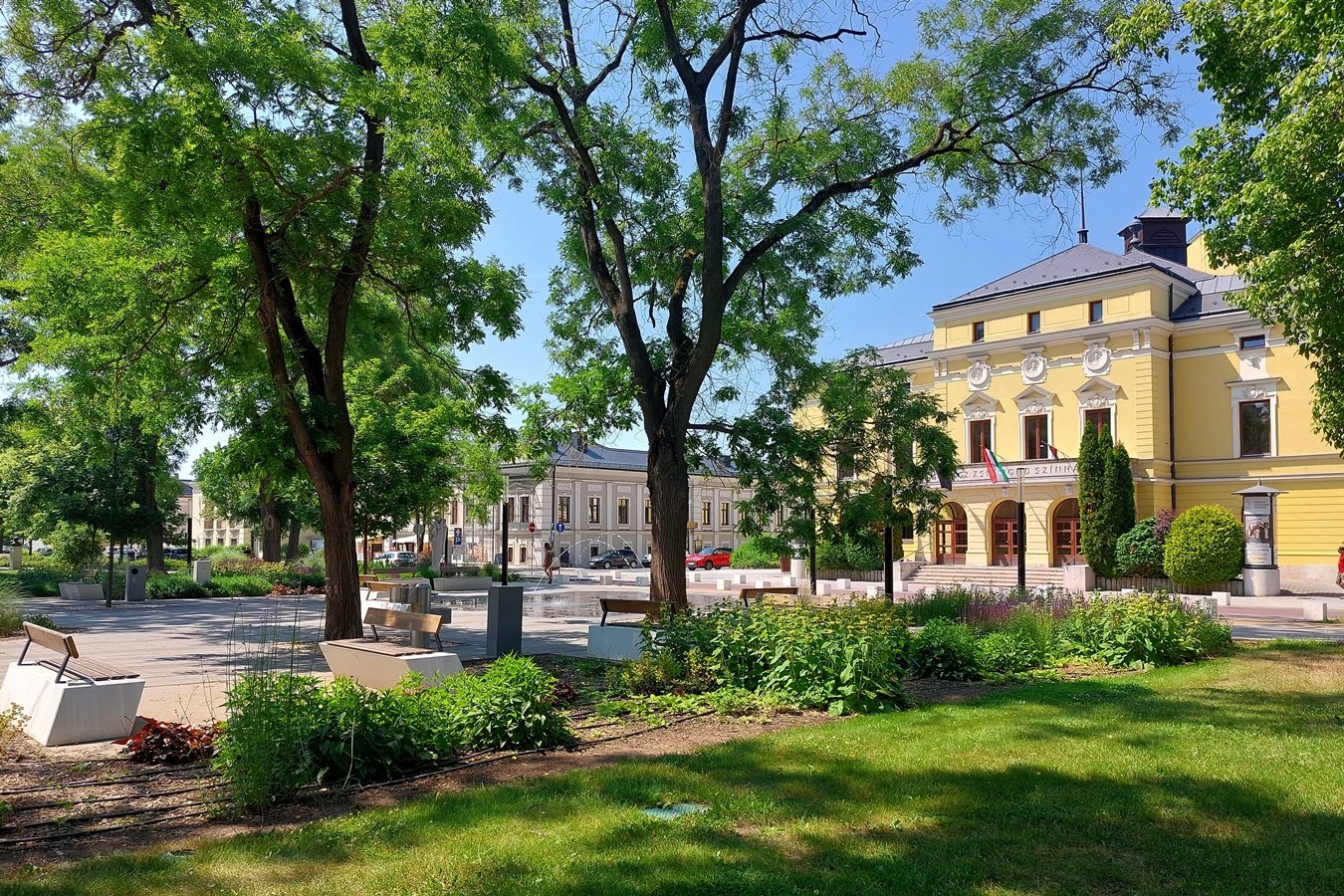
Its external facade is decorated by the reliefs of Moliere, Szigligeti and Shakespeare. In late August every year, the theatre organises VIDOR Festival, one of the biggest all arts festivals in the country. Opposite the theatre the statue of Mihály Váci (ifj. István Szabó, 1976), and a bit further to the south Gyula Krúdy (Imre Varga, 2003) commemorate the sons of the city.
Benczúr square
The monumental building on Benczúr square, showing the marks of neoclassicist style, is the Jósa András Museum, which got its name from the famous scientist and polyhistor. The Museum which had been renovated in the inside by spring 2008 hosts a rich repository of the relics of Nyíregyháza and the county. In addition to permanent exhibitions (archaeological, folk art, fine arts, a strong-room with the golden treasures of Újfehértó), visitors can take delight in valuable temporary exhibitions.
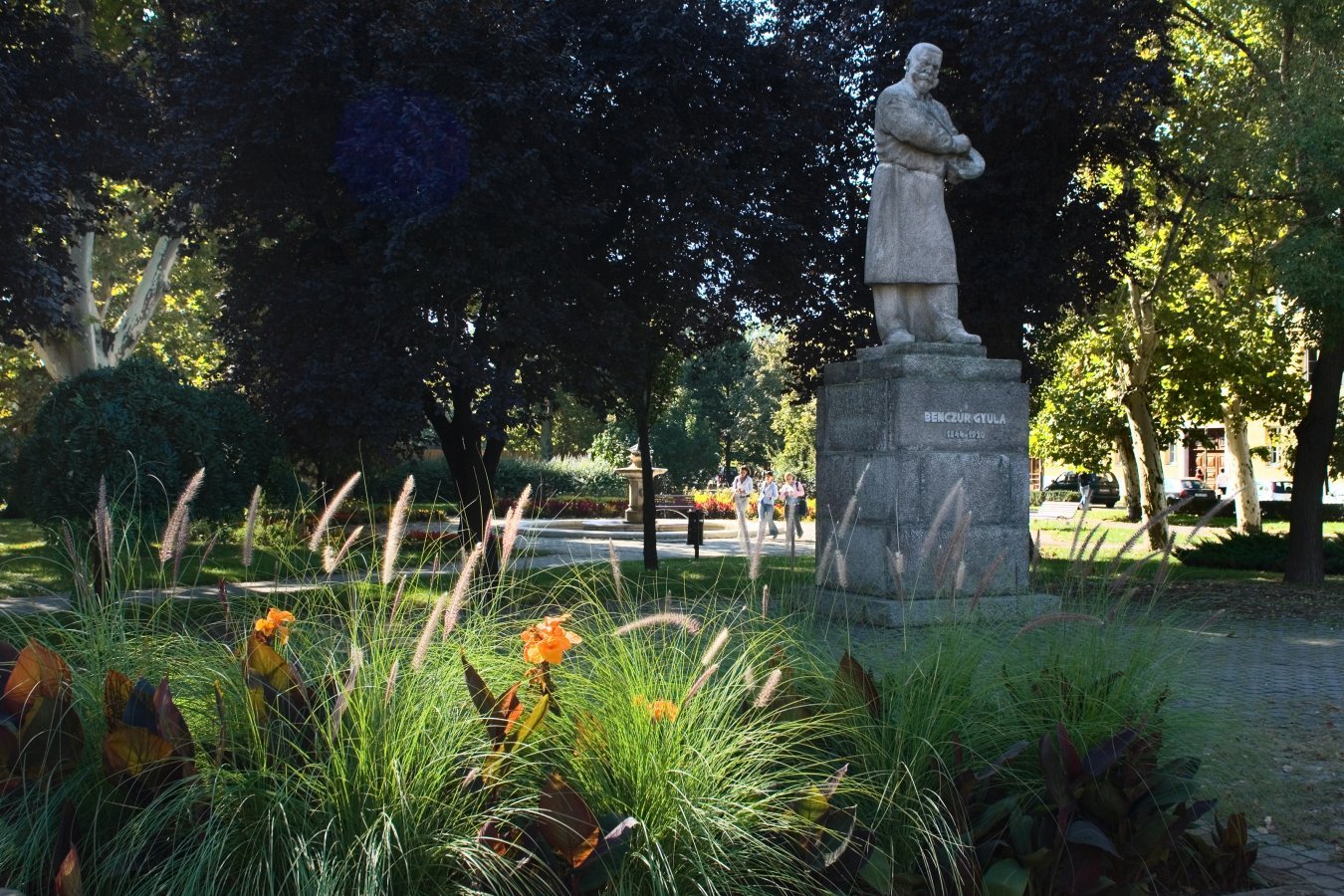
A few steps away you can see the statue of Gyula Benczúr, a painter born in Nyíregyháza, carved of limestone, created by Géza Galántai Fekete. Behind that, hidden among trees, on a foundation of a fountain the famous ‘The Birth of Venus’ statue by Zsigmond Kisfaludy Stróbl can be seen. The original of this statue stands in Santa Barbara, California, and was awarded golden prize in the Barcelona World’s Fair in 1929. The artist donated an authentic counterpart to the city. The slender pavilion building in the middle of the square has recently been renovated. Originally it was built in 1925 and served as the venue for a pastry-shop with music in the summer and then as a beer garden.
Luther square
Heading towards Iskola street you will arrive to the Baroque monument building of the evangelical church on Luther square. The Tirpaks who got settled in the area in 1753 started to build their stone church thanks to the edict of tolerance of Joseph II. It was designed by the Italian Giuseppe Aprilis. It was consecrated at the highest peak of the old city in 1786. As a venue of organ and choir concerts, the church fills a significant role in the music life of Nyíregyháza. Chime of bells on the building’s facade calls the attention to the passage of time.
The so-called Luther House, comprising two buildings next to the church, used to be the mansions of the Evangelic Church. The building was constructed in 1928 based on the designs of István Kotsis, and was the most modern block of flats at the time.
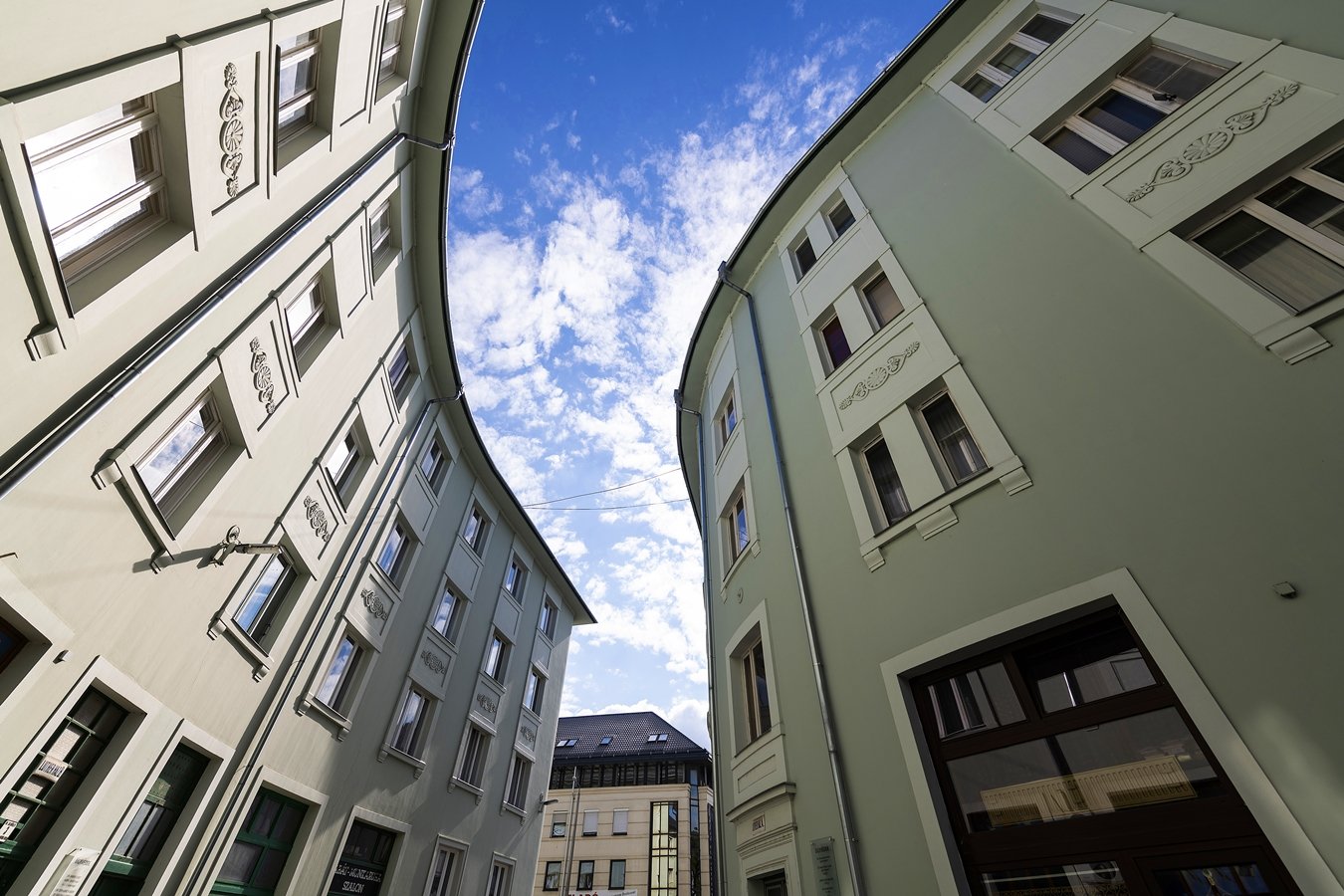
A few steps from the Luther House, on the wall of the house under Szent István u. 8, a memorial plaque informs visitors that this is the place where the house in which the famous writer and journalist Gyula Krúdy was born in 1878, used to stand. The Kossuth Lajos Evangelic Grammer School of Nyíregyháza, which was the first grammar school in the county, can also be found in this street. It was founded in 1806 by the evangelic church, and it became a grammar school in 1861. Its students included Gyula Krúdy the writer, János Kabay, a chemist and researcher, and Béla Gádor, writer and journalist.
The history of Nyíregyháza in a nutshell
Summing up the history of the city in a nutshell, we can say that – according to archaeological excavations – its area has been inhabited since the 10th century. Still, it’s considered a relatively young settlement, as real changes did not take place until the 18th century. 1753 saw the arrival of the Slovak settlers, called ‘Tirpaks’ today, who lived in the so-called ‘bush farms’ on weekdays around the city, providing the settlement with a special structure.
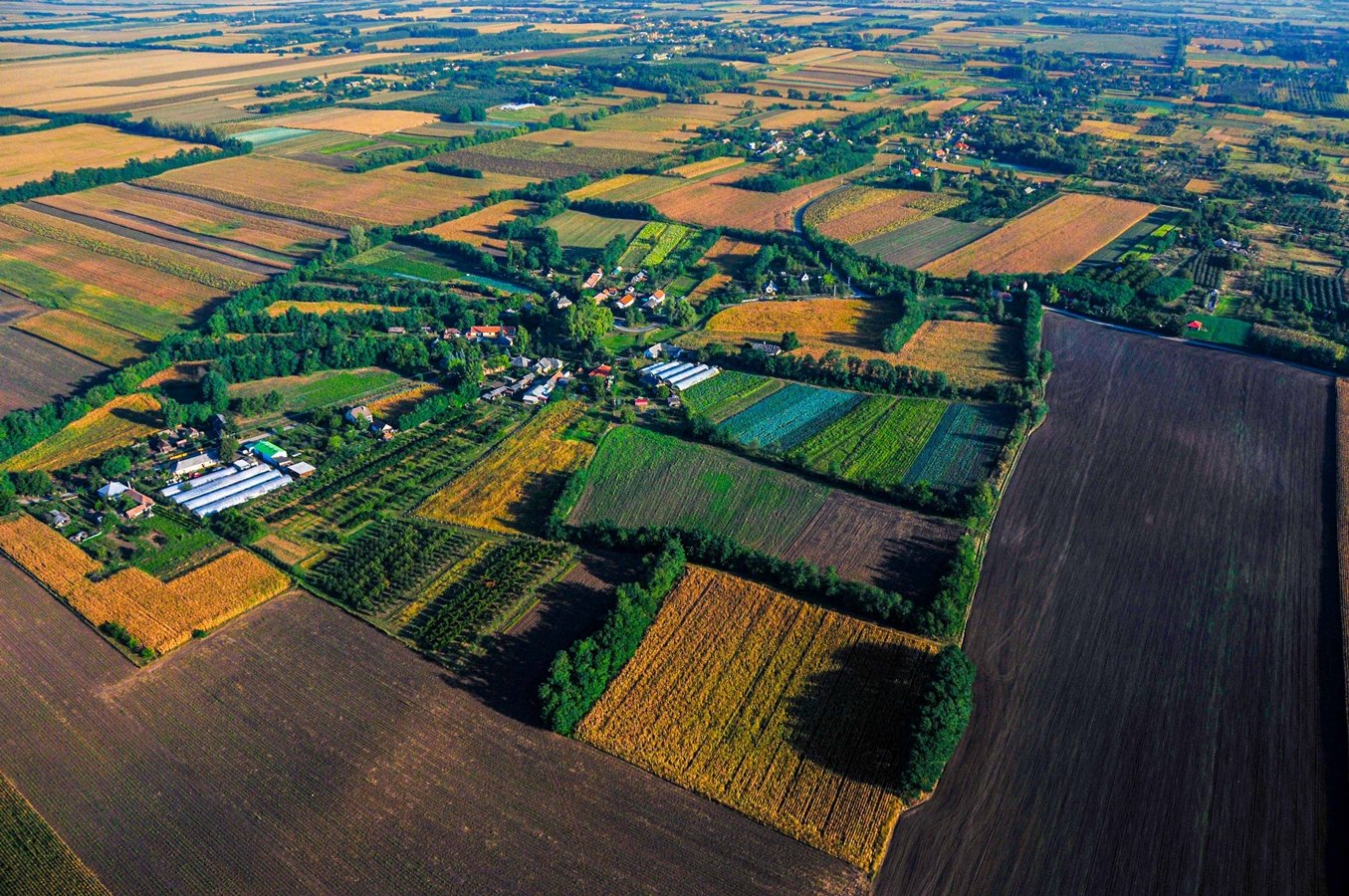
The most important event in the life of people in Nyíregyháza was the compulsory fee simple in 1824, when they redeemed themselves from the jurisdiction of the landowners, and this led to Nyíregyháza receiving city rank in 1837. Today, it is a beautiful city with a good atmosphere and a bustling life. The cityscape is formed by parks, squares, huge green areas, modern and old buildings, and still it managed to preserve its old intimate air.
Pictures of the downtown of Nyíregyháza
Map
4400 Nyíregyháza, Kossuth tér
4400 Nyíregyháza, Luther tér
4400 Nyíregyháza, Benczúr Gyula tér
4400 Nyíregyháza, Bessenyei tér
4400 Nyíregyháza, Országzászló tér
4400 Nyíregyháza, Kálvin tér
4400 Nyíregyháza, Október 23. tér
4400 Nyíregyháza, Hősök tere
4400 Nyíregyháza, Szabadság tér
4400 Nyíregyháza, Bocskai u.
4400 Nyíregyháza, Zrínyi Ilona u.


